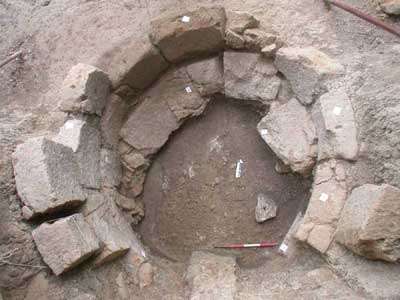

He and his army encamped at Caudium, where they awaited the arrival of a Roman consular army.

He decried any thought of surrender and proclaimed the just nature of the war on Rome. Roman pressure continued to build in the years after, and, in 321 BC, the Samnite council appointed the statesman Gaius Pontius as commander for the year. The war began with a Roman offensive into western Samnium, and Quintus Fabius Maximus Rullianus disobeyed orders by attacking a Samnite army and winning a great victory at Imbrinium. In 326 BC, a pro-Roman faction in Neapolis expelled the Samnite garrison and handed over the city to Roman control. However, hostilities between the Romans and the Samnite League resurfaced in 328 BC when a Roman colony was established at Fregellae on the Samnite side of the River Liris, and this, coupled with the expanding Roman presence in Campania, led to further deterioration of relations.

A hierarchy was created in which Rome's Latin subordinates no longer had military or diplomatic dealings with other powers, and the inhabitants of loyal cities such as Aricia and Lanuvium became Roman citizens, while the disloyal but crucial port city of Antium received the same perk, along with a Roman garrison. The Campanians and Sidicini were motivated to join the anti-Roman uprising, and, in 340 BC, the Romans crushed the uprising at Mount Vesuvius it was not until 337 BC that the Latins were forced to submit to Roman authority. In 343 BC, the Romans defeated the Samnites at Mons Gaurus, Saticula, and Suessula before the Romans could take advantage, however, Rome's Latin allies rose in rebellion in the " Latin War", forcing the Romans and Samnites to make peace and resume their alliance. However, relations quickly soured, as, just over a decade later, the Samnites attacked the Sidicini and Campanians who came to aid them.ĭespite their alliance with the Samnites, Rome was unwilling to risk a rival power gaining hegemony over Campania's agriculturally-rich land, and Rome intervened on behalf of the coastal confederation, whose members submitted themselves to the Republic. The League was normally governed by a central council made up of all four tribes led by a warchief, and, in 354 BC, the Roman Republic and the Samnites allied against a common enemy, the Volsci. The Samnites, who lived along the Apennine mountain range, were a tribal confederation consisting of the Hirpani, Caudini, Pentri, and Carricini, and the four, often-divided tribes made up the Samnite League. By the mid-4th century BC, Italy was still divided between Latins, Greeks, Etruscans, and other civilizations, with the Oscan-speaking, semi-nomadic Samnites being one of the most powerful nations on the peninsula.


 0 kommentar(er)
0 kommentar(er)
